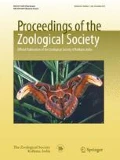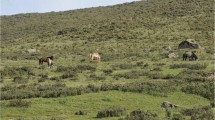Abstract
The house crows Corvus splendens Vieillot are accustomed to construct nest in suitable trees belonging to certain species. In the present study an attempt was made to draw the affinity of crows with the nest-tree species occurring in and around Kolkata (22°34′N, 88°24′E), West Bengal, India. Accordingly, survey was conducted in different road side trees during the period of eight consecutive breeding seasons from 2006 to 2013. Of the recorded 46 nest-tree species belonging to 27 families, irrespective of Ivlev’s and Jacobs preference indices, 13 were of ‘exclusive selection’, 2 were of ‘no active selection’ and 16 were of ‘complete avoidance selection’ by C. splendens for nesting. The status of the remaining 15 nest-tree species were either avoiding or no active selection in nature. Out of 13 exclusive/complete selection nest-tree species 8 species harboured 85.65 % of the total 1,171 nests recorded out of 3,083 nests in course of studies. Apart from canopy configuration, leaf phenology and food resource mobilization these nest-tree species had a number of spots, amongst the ramifications, presenting a platform because of agglomeration of 2–3, 4–5 or more than 5 suitable branches. As such kinds of spots were the sites for construction of nest by C. splendens; it is imperative that the said factor determines the affinity of house crows with the nest-tree species.








Similar content being viewed by others
References
Ali, S. 2002. The book of Indian birds, 13th ed. New Delhi: Bombay Natural History Society, Oxford University Press.
Ali, S., and S.D. Ripley. 1972. Handbook of the birds of India and Pakistan, Corvideae. Bombay: Oxford University Press.
Allan, D.G., and G.B. Davies. 2005. Breeding biology of house crows (Corvus splendens) in Durban. South Africa. Ostrich 76(1–2): 21–32.
Berruti, A., and G. Nichols. 1991. Alien birds in southern Africa: The crow must go. Birding in Southern Africa 43: 52–57.
Bijlsma, R.G., and P.L. Meininger. 1984. Behaviour of the house crow, Corvus splendens, and additional notes on its distribution. Le Gerfaut 74: 3–13.
Campbell, R.C. 1989. Statistics for biologists, 3rd ed. Cambridge: Cambridge University Press.
Dolenec, Z. 2006. Nest density, clutch size and egg dimensions of the Hooded Crow (Corvus carone cornix). Natura Croatica 15: 231–233.
Dutta, S.K. 2007. Nest site selection by house crows on Diamond Harbour Road in Kolkata, India. http://voices.yahoo.com/nest-site-selection-house-crows-diamond-harbour-573390.html?cat=10. Accessed 10 Nov 2013.
Dutta, S.K., and S.K. Raut. 2010a. Height of the nesting spots of the house crows Corvus splendens in the nest-building trees in Kolkata, India. Enviroment & Ecology 28(1): 194–197.
Dutta, S.K., and S.K. Raut. 2010b. On the significance of selection of corner-point trees for nesting by the crows, Corvus splendens occurring in greater Kolkata, India. Journal of Natural History (India) 6(1): 46–53.
Dutta, S.K., and S.K. Raut. 2010c. Chase-responses to human intruder by the chick-bearing nesting crows Corvus splendens. Environment & Ecology 28(3A): 1734–1739.
Dutta, S.K., and S.K. Raut. 2013. Nesting site of house crow: Tree versus light-post-an impact assessment. Proceedings of the Zooogical Society of Calcutta 66(2): 141–148.
Feare, C.J., and Y. Mungroo. 1989. Notes on the house crow Corvus splendes in Mauritius. Bulletin of the British Ornithologists’ Club 109: 199–201.
Fry, C.H., S. Keith, and E.K. Urban. 2000. The birds of Africa, vol VI. London: Academic Press.
Gadgil, M. 2001. Project lifescape: 9. Crows. Resonance, February 2001: 74–82.
Ivlev, V.S. 1961. Experimental ecology of the feeding fishes. New Haven: Yale University Press.
Jacobs, J. 1974. Quantitative measurement of food selection. Oecologia 14: 413–417.
Kasprzykowski, Z. 2003. Habitat preferences of foraging Rooks Corvus frugilegus during the breeding period in the agricultural landscape of eastern Poland. Acta Ornithologica 38(1): 27–31.
Löhmus, A. 2006. Nest-tree and nest-stand characteristics of forest-dwelling raptors in east- central Estonia: implications for forest management and conservation. Proceedings of the Estonian Academy of Science Biology and Ecology 55: 31–50.
Löhmus, A., and U. Sellis. 2003. Nest trees a limiting factor for the the Black Stork (Ciconia nigra) population in Estonia. Aves 40: 84–91.
Madge, S., and H. Burn. 1993. Crows and Jays. London: C. Helm.
Meininger, P.L., W.C. Mullie, and B. Bruun. 1980. The spread of the house crow, Corvus splendens, with special reference to the occurrence in Egypt. Le Gerfaut 70: 245–250.
Mudappa, D. 2000. Breeding biology of the Malabar Grey Hornbill (Ocyceros griseus) in southern Western Ghats, India. Journal of Bombay Natural History society 97: 15–24.
Mudappa, D., and R. Kannan. 1997. Nest-site characteristics and nesting success of the Malabar Grey Hornbill in the Southern Western Ghats, India. Wilson Bulletin 109: 102–111.
Nakamura, S. 2000. Nest site comparisons between the Carrion Crow Corvus corone and Jungle Crow Corvus macrorhynchos in Takatsuki city. Japanese Journal of Ornithology 49: 39–50.
Nitawriter 2009. http://nitawriter.wordpress.com/2009/05/25/the-indian-house-crow-should-not-thrive. Accessed 2 Nov 2013.
Runde, D.E., and D.E. Capen. 1987. Characteristics of northern hardwood trees used by cavity- nesting bird species. Journal of Wildlife Management 51: 217–223.
Ryall, C. 1994. Recent extensions of range in the house crow Corvus splendens. Bulletin of the British Ornithoogists’ Club 114: 90–100.
Ryall, C. 1995. Additional records of range extension in the house crow Corvus splendens. Bulletin of the British Ornithoogists’ Club 115(3): 185–187.
Santoshkumar, E., and P. Balasubramanian. 2010. Breeding behavoiur and nest tree use by Indian Grey Hornbill Ocyceros birostris in the Eastern Ghats, India. Forktail 26: 82–85.
Seig, C.H. 1991. Geographic affinity of bird species associated with Rocky Mountain Juniper Woodlands and adjacent grassland in Southwestern south Dakota. Prairie Naturalist 23: 25–33.
Soh, M.C.K., N.S. Sodhi, R.K.H. Seoh, and B.W. Brook. 2002. Nest site selection of the house crow Corvus splendens, an urban invasive bird species in Singapore and implications for its management. Landscape and Urban Planning 59: 217–226.
Vorgin, M. 1998. Abundance and habitat selection of breeding Corvus corone cornix on agricultural land in Central Slovenjia. Acta Zoologica Literature of Ornithology 8: 127–130.
Yahner, R.H., and J.W. Grimm. 1993. Nest tree use by hawks in Pennsylvania. Journal of the Pennsylvania Academy of Science 67: 40–41.
Zduniak, P., and L. Kuczyński. 2003. Breeding biology of the Hooded Crow Corvus corone cornix in Warta river valley (W Poland). Acta Ornitholigca 38: 143–150.
Acknowledgments
The authors are thankful to the Head of the Department of Zoology, University of Calcutta for the facilities provided and grateful to Prof. B. N. Bhattacharyya and Prof. B. Manna for valuable comments.
Author information
Authors and Affiliations
Corresponding author
Rights and permissions
About this article
Cite this article
Dutta, S.K., Raut, S.K. Affinity of House Crows (Corvus splendens) with Nesting Trees occurring in and around Kolkata, India. Proc Zool Soc 68, 96–108 (2015). https://doi.org/10.1007/s12595-014-0101-z
Received:
Revised:
Accepted:
Published:
Issue Date:
DOI: https://doi.org/10.1007/s12595-014-0101-z




